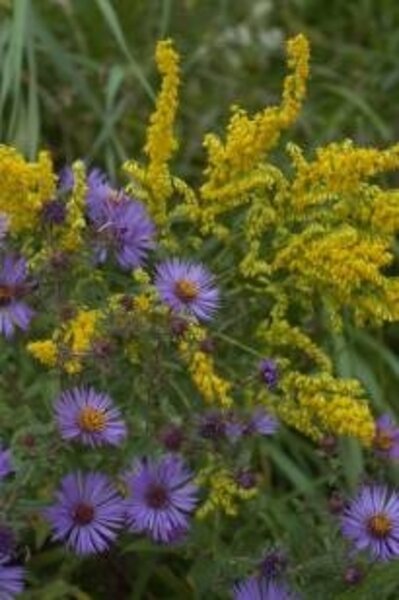Asters and goldenrod, perfect autumn garden companions
Loading...
When working as a children’s librarian years ago, I came across a native American legend about two girls, one dressed in purple, one in gold. Survivors of a besieged village, they escaped to an herbalist with magic powers who, foreseeing that the girls would be killed, turned them into flowers — the aster and the goldenrod — so they could avoid their fate and remain together forever.
I’ve lost track of the story, but the aster and the goldenrod still appear every autumn, dressing up pastures and trimming roadsides. Goldenrod, considered too aggressive for gardens, was left in the wild until quite recently, when cultivated varieties became available.
But our colonial forerunners transplanted asters into their borders and beds, and sent them back across the Atlantic, where they were crossed and recrossed until seen as genteel enough to be worthy of a place in the garden.
Like those early varieties, most of the fall-blooming asters sold today are the consequence of hybridizing the New England aster (formerly Aster novae-angliae, now Symphyotrichum novae-angliae) and the New York aster (formerly A. novi-belgii, now Symphyotrichum novi-belgii).
Their new taxonomic assignment, Symphyotrichum, is a result of molecular research that left "Old World” asters as asters. but moved all but one North American asters into other genera.
The consensus is that the new genus name is pronounced sim-fy-oh-TRY-kum, an appellation that doesn’t exactly roll off the lips. Poems aren’t the same when “sim-fy-oh-TRY-kum” is substituted for “aster.” The change comes from the same experts who changed Chrysanthemum to Dendranthema and then back to Chrysanthemum, and turned Coleus blumei, good old painted nettle, to Solenostemon scutellarioides. Try saying that three times fast. Or slow.
Fortunately, these taxonomists meet only every five years.
But back to asters. Our natives tend to be tall and a bit weedy, but their hybrid offspring retain their parents’ vigor, grow more compactly, bloom more generously, and sport colors not seen in roadside ditches. While there are fine tall cultivars, I like the shorter types, plants in the 12- to 18-inch range. I hate staking plants, so over the years I’ve stayed with compacts, including the blue old-timer ‘Professor Kippenburg’, white ‘Snow Cushion’, ‘Wood’s Blue’, ‘Purple Dome’, and ‘Lady-in-Blue’.
We have moved to a property with plenty of sun, which is the essential to growing asters, so I’m going to track down other cultivars that won’t blow over in the winds that come off Lake Champlain. (A quick Google search using “aster, compact” suggests there are plenty of candidates.)
Some shorter varieties are susceptible to powdery mildew, a fungus that makes that the plant look as if it’s been sprinkled with flour. But tall asters. too, are susceptible to powdery mildew, and nearly always must be shored up, and often lose their lower leaves, exposing their ungainly ankles. Choose your poison.
For the record, there is an all-gold aster, A. linosyris, a native of the British Isles commonly known as Goldilocks. But no historically sensitive American gardener would grow this green alien: Gold, the legend tells us, belongs to the aster’s childhood companion, the goldenrod.
Karan Davis Cutler, a former magazine editor and newspaper columnist, is the author of scores of garden articles and more than a dozen books, including “Burpee - The Complete Flower Gardener” and “Herb Gardening for Dummies.” She now struggles to garden in the unyieldingly dense clay of Addison County, Vermont, on the shore of Lake Champlain, where she is working on a book about gardening to attract birds and other wildlife. She will be blogging regularly for Diggin’ It.
Editor’s note: To read more posts by Karan, see our blog archive. The Monitor’s main gardening page offers articles on many gardening topics. See also our RSS feed. You may want to visit Gardening With the Monitor on Flickr. Take part in the discussions and get answers to your gardening questions. If you join the group (it’s free), you can upload your garden photos and enter our next contest.






